Hamartia Antidote
ELITE MEMBER

- Joined
- Nov 17, 2013
- Messages
- 35,188
- Reaction score
- 30
- Country
- Location
https://www.businessinsider.com/big...porter-inside-interior-pictures-photos-2019-9
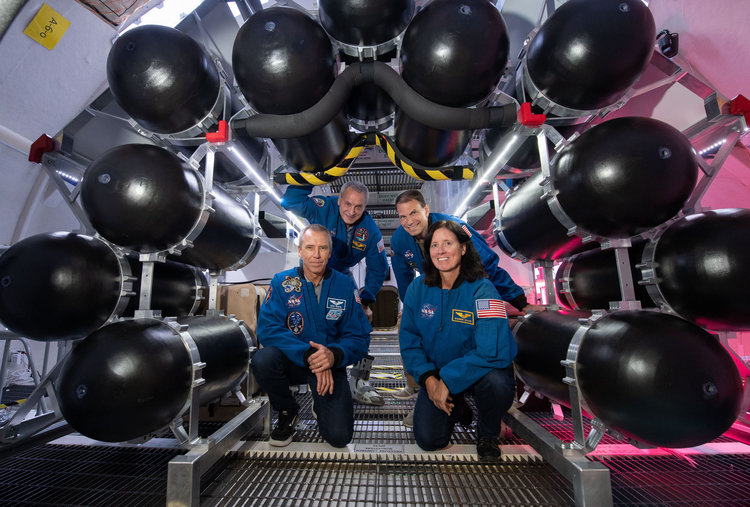 Bigelow Aerospace via Imgur
Bigelow Aerospace via Imgur
On Thursday, the billionaire unveiled Bigelow Aerospace's latest model of an expandable space-station prototype, the Bigelow Mars Transporter Testing Unit. The mock-up has the volume of four 40-foot-long cargo containers and was built in part for NASA astronauts and engineers to try.
Bigelow's immediate goal is to persuade NASA, which is testing prototypes made by four other companies, to fund a space-worthy unit, called the B330 (so named because it would have 330 cubic meters of volume). The work is in support of the space agency's $20 billion to $30 billion Artemis moon-landing program.
Artemis currently calls for housing astronauts inside a moon-orbiting space station called the Gateway. That way, there'd be a helpful pit stop between the lunar surface and Earth. In the more distant future, the Gateway may serve as a stepping stone to Mars.
Bigelow is interested in helping NASA with both goals using the B330.
"It is important to listen to what President Trump has been saying about Mars. The way to Mars is to the moon. The way to the moon is through the Gateway," Bigelow said in a statement to Business Insider ahead of the unveiling. "The B330 is an exploration destined space station, and we are excited about its future."
Bigelow Aerospace built its demo unit to house astronauts for three days, and the company provided interior pictures of its setup. Take a look inside.
Robert Bigelow made his billions from the hotel chain Budget Suites of America. Like billionaires such as Elon Musk, Jeff Bezos, and Richard Branson, he's using his fortune to develop new spaceflight hardware.

Bigelow presenting his plans to launch inflatable space stations for tourists.
Associated Press
Bigelow is known for his work on advancing inflatable space stations, an idea that emerged from NASA in the 1990s. Private outposts, or "space hotels," could support tourism, research, and other commercial interests that the International Space Station could not.
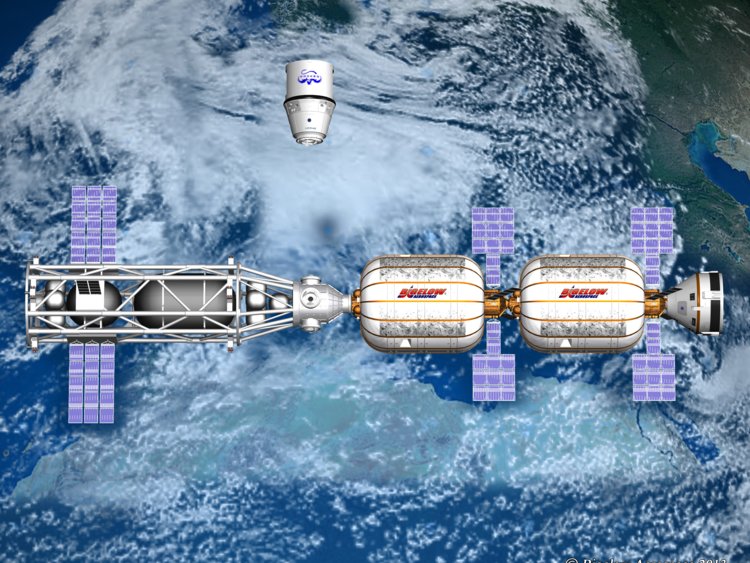
An artist's concept of a Bigelow space station.
Bigelow Aerospace
The basic idea: It's much cheaper to launch habitats folded up to a fraction of their size, then inflate them once in space. There'd also be more room than the rigid metal hulls of traditional space modules allow.

SpaceX's Falcon 9 rocket lifts off with the Bigelow Expandable Activity Module inside on its CRS-8 mission on April 8, 2016.
SpaceX/Flickr
So far, the company has an impressive track record. It has launched several working prototypes into space, the latest of which is the Bigelow Expandable Activity Module, or BEAM, which is attached to the International Space Station.

BEAM is attached to the International Space Station.
NASA; Bigelow Aerospace via Imgur; Business Insider
Astronauts and cosmonauts welcomed the addition in April 2016.

Expedition 57 inside the Bigelow Expandable Activity Module.
NASA; Bigelow Aerospace via Imgur
But Bigelow has bigger plans with the far larger and more ambitious B330 model.

An illustration of XBASE, the Expandable Bigelow Advanced Station Enhancement, a B330 module, on the forward node of the International Space Station.
Bigelow Aerospace via Imgur
"Equipped with two galleys, two toilets, enormous cargo space, and two dissimilar propulsion systems, this is the ideal habitat for a long-duration space mission," Bigelow said in a statement on Thursday.

A cutaway diagram of Bigelow Aerospace's B330 inflatable space station.
Facebook/Bigelow Aerospace
Bigelow Aerospace built the Mars Transporter Testing Unit, a steel-hulled variant that's not supposed to launch into space, in its Las Vegas facility. The company is using it to test internal layouts — and encourage NASA to provide more funding to develop the concept.
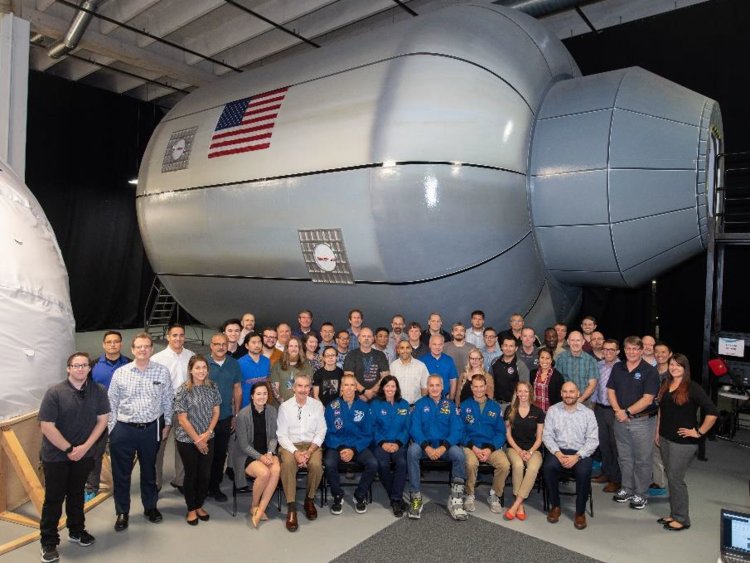
An outside view of the test unit, with Bigelow, NASA astronauts, and others shown for scale.
Bigelow Aerospace
The hatch of the B330 contains about a dozen large air tanks. Once in space, the tanks would release their gases to inflate the final B330 unit to its full operational size.

NASA astronauts inside the Bigelow Mars Transporter Testing Unit.
Bigelow Aerospace via Imgur
The hatch leads into the core of the B330, which Bigelow envisions being packed with cargo before a launch. Cold storage for food, research, and other supplies is in this middle deck.
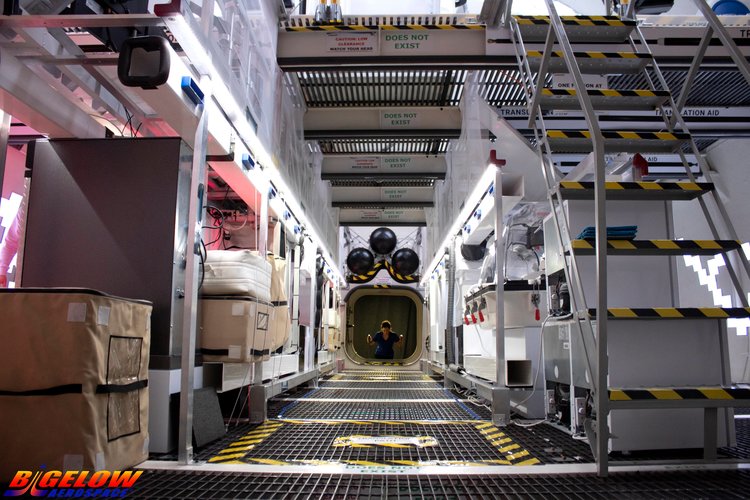
Inside the middle deck of the Bigelow Mars Transporter Testing Unit.
Bigelow Aerospace via Imgur
There are three decks. The lower deck is for crew members' sleeping, storage, and entertainment; the middle deck is for science experiments, cold storage, workstations, galleys, and growing food; and the upper deck is for medical use and exercise.

Inside the middle deck of the Bigelow Mars Transporter Testing Unit.
Bigelow Aerospace via Imgur
Glove boxes could be used to study and pack lunar samples, or carry out biological experiments. Shown at right is a 3D printer, and in the center is a surface for laboratory work. The domed ends of the B330 would store large amounts of supplies.
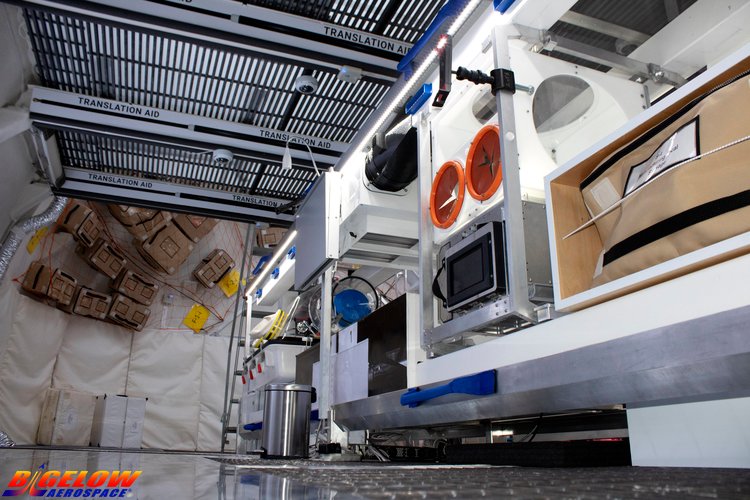
Inside the middle deck of the Bigelow Mars Transporter Testing Unit.
Bigelow Aerospace via Imgur
Bigelow also envisions vegetable growth pods next to the galley. Crew members would also have access to B330 navigation controls, a station to remotely operate lunar rovers, and other guidance systems.

Inside the middle deck of the Bigelow Mars Transporter Testing Unit.
Bigelow Aerospace via Imgur
The upper deck houses a medical research area, a medical isolation unit, and two individual toilets — the same number as on the football-field-size International Space Station. An exercise area is on the other side of the white partition.
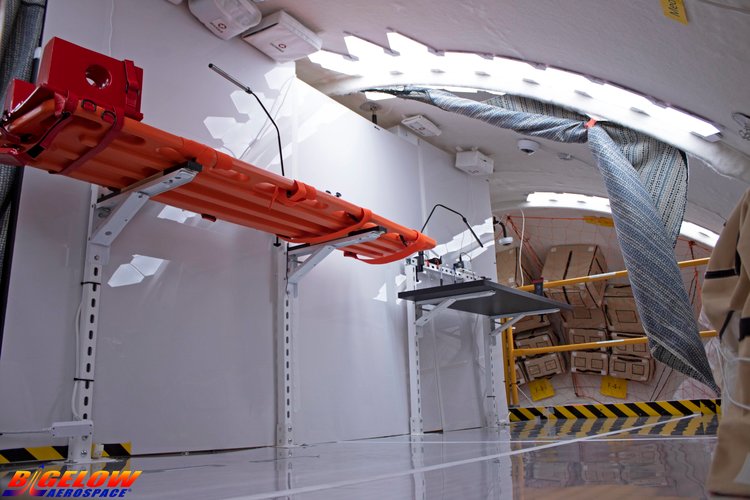
This is the upper deck of the Bigelow Mars Transporter Testing Unit.
Bigelow Aerospace via Imgur
The lowest deck houses four crew quarters, individual crew lockers, and separate hygiene booths for crew members to wipe down their bodies (the closest one gets to a shower in microgravity).

Inside the lowest deck of the Bigelow Mars Transporter Testing Unit.
Bigelow Aerospace via Imgur
Next to the hygiene booths is an entertainment area with flexible-screen TVs.

Inside the lowest deck of the Bigelow Mars Transporter Testing Unit.
Bigelow Aerospace via Imgur
Bigelow Aerospace hopes the two-week demonstration of the Mars Transporter Testing Unit will, in part, help convince NASA that it's the company to build out the Gateway for Artemis.
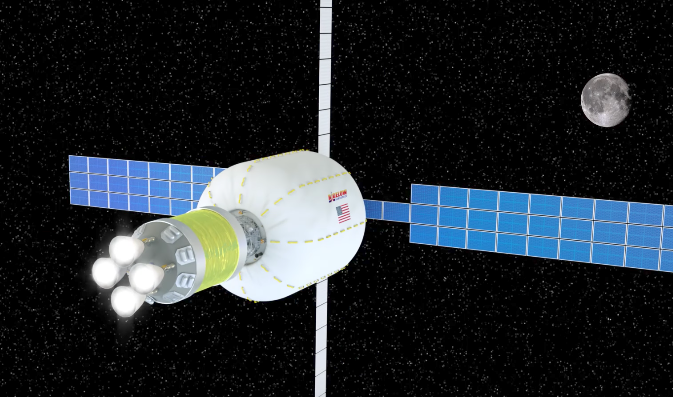
A conceptual image of an upper-stage rocket sending a B330 inflatable space habitat into lunar orbit.
YouTube - Bigelow Aerospace
It envisions the Gateway as two B330 units linked in lunar orbit. This would provide one-third of the volume currently used by astronauts and cosmonauts aboard the International Space Station at a much lower cost per cubic meter, in much fewer launches over less time.
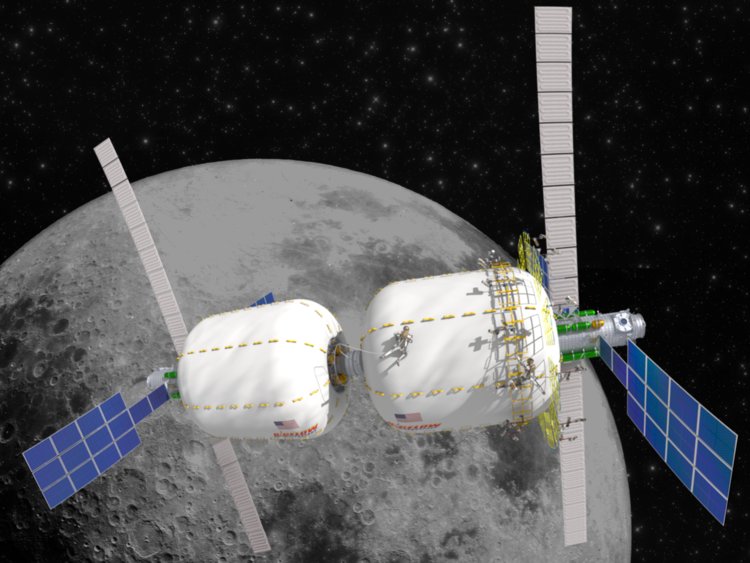
A conceptual image of two B330 inflatable space habitats that Bigelow Aerospace hopes will comprise the Gateway lunar space station in support of the Artemis moon-landing program.
Bigelow Aerospace
But Bigelow is already thinking ahead with the B330, as evidenced by the name of his ground prototype. "This large space station can accommodate four people indefinitely and five people for many months," he said — perhaps long enough to send a crew to Mars.
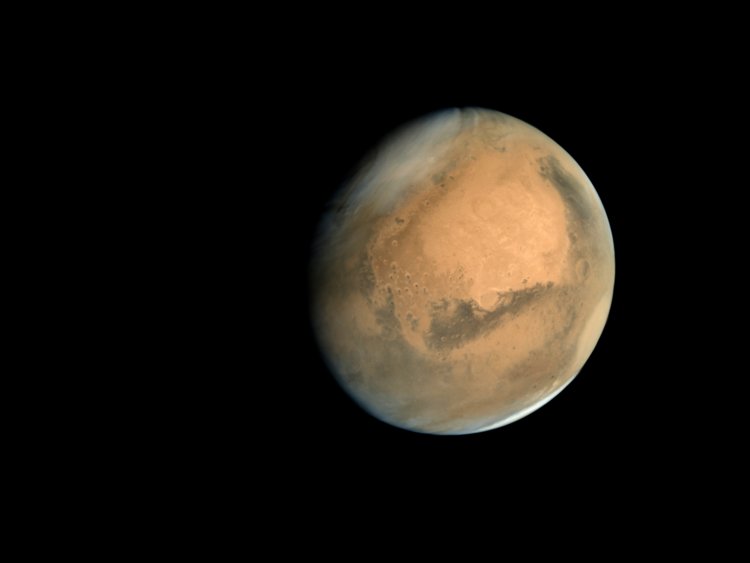
A photo illustration of the red planet using imagery taken by the Mars Orbiter Mission.
ISRO/ISSDC/Emily Lakdawalla (CC BY-NC-SA 3.0)

- The hotel billionaire Robert Bigelow is dedicating part of his fortune to designing and building inflatable space habitats.
- On Thursday, his company Bigelow Aerospace unveiled its "Mars Transporter" test unit in Las Vegas. As part of a two-week ground test for NASA, astronauts will spend three days inside trying it out.
- The test unit is an early prototype of the B330, a habitat Bigelow wants NASA to use for its Artemis moon-landing program and, later on, travel to Mars.
- "Equipped with two galleys, two toilets, enormous cargo space, and two dissimilar propulsion systems, this is the ideal habitat for a long-duration space mission," Bigelow said.
- Visit Business Insider's homepage for more stories.
On Thursday, the billionaire unveiled Bigelow Aerospace's latest model of an expandable space-station prototype, the Bigelow Mars Transporter Testing Unit. The mock-up has the volume of four 40-foot-long cargo containers and was built in part for NASA astronauts and engineers to try.
Bigelow's immediate goal is to persuade NASA, which is testing prototypes made by four other companies, to fund a space-worthy unit, called the B330 (so named because it would have 330 cubic meters of volume). The work is in support of the space agency's $20 billion to $30 billion Artemis moon-landing program.
Artemis currently calls for housing astronauts inside a moon-orbiting space station called the Gateway. That way, there'd be a helpful pit stop between the lunar surface and Earth. In the more distant future, the Gateway may serve as a stepping stone to Mars.
Bigelow is interested in helping NASA with both goals using the B330.
"It is important to listen to what President Trump has been saying about Mars. The way to Mars is to the moon. The way to the moon is through the Gateway," Bigelow said in a statement to Business Insider ahead of the unveiling. "The B330 is an exploration destined space station, and we are excited about its future."
Bigelow Aerospace built its demo unit to house astronauts for three days, and the company provided interior pictures of its setup. Take a look inside.
Robert Bigelow made his billions from the hotel chain Budget Suites of America. Like billionaires such as Elon Musk, Jeff Bezos, and Richard Branson, he's using his fortune to develop new spaceflight hardware.

Bigelow presenting his plans to launch inflatable space stations for tourists.
Associated Press
Bigelow is known for his work on advancing inflatable space stations, an idea that emerged from NASA in the 1990s. Private outposts, or "space hotels," could support tourism, research, and other commercial interests that the International Space Station could not.

An artist's concept of a Bigelow space station.
Bigelow Aerospace
The basic idea: It's much cheaper to launch habitats folded up to a fraction of their size, then inflate them once in space. There'd also be more room than the rigid metal hulls of traditional space modules allow.

SpaceX's Falcon 9 rocket lifts off with the Bigelow Expandable Activity Module inside on its CRS-8 mission on April 8, 2016.
SpaceX/Flickr
So far, the company has an impressive track record. It has launched several working prototypes into space, the latest of which is the Bigelow Expandable Activity Module, or BEAM, which is attached to the International Space Station.

BEAM is attached to the International Space Station.
NASA; Bigelow Aerospace via Imgur; Business Insider
Astronauts and cosmonauts welcomed the addition in April 2016.

Expedition 57 inside the Bigelow Expandable Activity Module.
NASA; Bigelow Aerospace via Imgur
But Bigelow has bigger plans with the far larger and more ambitious B330 model.

An illustration of XBASE, the Expandable Bigelow Advanced Station Enhancement, a B330 module, on the forward node of the International Space Station.
Bigelow Aerospace via Imgur
"Equipped with two galleys, two toilets, enormous cargo space, and two dissimilar propulsion systems, this is the ideal habitat for a long-duration space mission," Bigelow said in a statement on Thursday.

A cutaway diagram of Bigelow Aerospace's B330 inflatable space station.
Facebook/Bigelow Aerospace
Bigelow Aerospace built the Mars Transporter Testing Unit, a steel-hulled variant that's not supposed to launch into space, in its Las Vegas facility. The company is using it to test internal layouts — and encourage NASA to provide more funding to develop the concept.

An outside view of the test unit, with Bigelow, NASA astronauts, and others shown for scale.
Bigelow Aerospace
The hatch of the B330 contains about a dozen large air tanks. Once in space, the tanks would release their gases to inflate the final B330 unit to its full operational size.

NASA astronauts inside the Bigelow Mars Transporter Testing Unit.
Bigelow Aerospace via Imgur
The hatch leads into the core of the B330, which Bigelow envisions being packed with cargo before a launch. Cold storage for food, research, and other supplies is in this middle deck.

Inside the middle deck of the Bigelow Mars Transporter Testing Unit.
Bigelow Aerospace via Imgur
There are three decks. The lower deck is for crew members' sleeping, storage, and entertainment; the middle deck is for science experiments, cold storage, workstations, galleys, and growing food; and the upper deck is for medical use and exercise.

Inside the middle deck of the Bigelow Mars Transporter Testing Unit.
Bigelow Aerospace via Imgur
Glove boxes could be used to study and pack lunar samples, or carry out biological experiments. Shown at right is a 3D printer, and in the center is a surface for laboratory work. The domed ends of the B330 would store large amounts of supplies.

Inside the middle deck of the Bigelow Mars Transporter Testing Unit.
Bigelow Aerospace via Imgur
Bigelow also envisions vegetable growth pods next to the galley. Crew members would also have access to B330 navigation controls, a station to remotely operate lunar rovers, and other guidance systems.

Inside the middle deck of the Bigelow Mars Transporter Testing Unit.
Bigelow Aerospace via Imgur
The upper deck houses a medical research area, a medical isolation unit, and two individual toilets — the same number as on the football-field-size International Space Station. An exercise area is on the other side of the white partition.

This is the upper deck of the Bigelow Mars Transporter Testing Unit.
Bigelow Aerospace via Imgur
The lowest deck houses four crew quarters, individual crew lockers, and separate hygiene booths for crew members to wipe down their bodies (the closest one gets to a shower in microgravity).

Inside the lowest deck of the Bigelow Mars Transporter Testing Unit.
Bigelow Aerospace via Imgur
Next to the hygiene booths is an entertainment area with flexible-screen TVs.

Inside the lowest deck of the Bigelow Mars Transporter Testing Unit.
Bigelow Aerospace via Imgur
Bigelow Aerospace hopes the two-week demonstration of the Mars Transporter Testing Unit will, in part, help convince NASA that it's the company to build out the Gateway for Artemis.

A conceptual image of an upper-stage rocket sending a B330 inflatable space habitat into lunar orbit.
YouTube - Bigelow Aerospace
It envisions the Gateway as two B330 units linked in lunar orbit. This would provide one-third of the volume currently used by astronauts and cosmonauts aboard the International Space Station at a much lower cost per cubic meter, in much fewer launches over less time.

A conceptual image of two B330 inflatable space habitats that Bigelow Aerospace hopes will comprise the Gateway lunar space station in support of the Artemis moon-landing program.
Bigelow Aerospace
But Bigelow is already thinking ahead with the B330, as evidenced by the name of his ground prototype. "This large space station can accommodate four people indefinitely and five people for many months," he said — perhaps long enough to send a crew to Mars.

A photo illustration of the red planet using imagery taken by the Mars Orbiter Mission.
ISRO/ISSDC/Emily Lakdawalla (CC BY-NC-SA 3.0)


